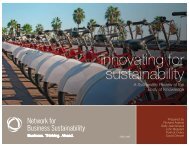embedding sustainability in organizational culture - Network for ...
embedding sustainability in organizational culture - Network for ...
embedding sustainability in organizational culture - Network for ...
Create successful ePaper yourself
Turn your PDF publications into a flip-book with our unique Google optimized e-Paper software.
Chapter 1: 3: Introduction Foster<strong>in</strong>g Commitment<br />
21<br />
The practice of <strong>in</strong><strong>for</strong>mal recognition is mentioned frequently by practitioners and<br />
researchers. Unlike the <strong>for</strong>mal practice of <strong>in</strong>centives <strong>in</strong> which compensation is<br />
directly tied to specific <strong>susta<strong>in</strong>ability</strong> measures or outcomes, recognition <strong>in</strong>volves<br />
<strong>in</strong><strong>for</strong>mal attempts to <strong>in</strong>dicate approval or appreciation <strong>for</strong> ef<strong>for</strong>ts to improve<br />
<strong>organizational</strong> <strong>susta<strong>in</strong>ability</strong>.<br />
Doppelt (2003) recommends the creation of awards as well as celebrat<strong>in</strong>g<br />
<strong>susta<strong>in</strong>ability</strong> successes regularly. In contrast, Willard (2009) cautions that rewards<br />
and celebrations may produce short-term results rather than long-term motivation.<br />
Based on their f<strong>in</strong>d<strong>in</strong>gs, researchers have also suggested that reward<strong>in</strong>g <strong>in</strong>dividual<br />
ef<strong>for</strong>ts can help build commitment to <strong>susta<strong>in</strong>ability</strong> (Angel del Brio et al., 2008;<br />
Smith & Brown, 2003).<br />
In the <strong>in</strong>novation literature, Beck (1987) describes how employees adopted Bank<br />
of America’s <strong>in</strong>novation <strong>culture</strong> through small gestures of recognition. A small p<strong>in</strong><br />
presented by the CEO or high-level management gave encouragement to employees<br />
who enacted the organization’s values and refocused management styles toward<br />
promot<strong>in</strong>g and support<strong>in</strong>g these values. The chief executives <strong>in</strong> Stop<strong>for</strong>d and Baden-<br />
Fuller’s study (1994) encouraged <strong>in</strong>novation through f<strong>in</strong>ancial and status rewards<br />
<strong>for</strong> teams and <strong>in</strong>dividuals. Blackburn and Rosen (1993), <strong>in</strong> their study of <strong>embedd<strong>in</strong>g</strong><br />
<strong>culture</strong>s of quality improvement, f<strong>in</strong>d that awards communicate to employees that<br />
the organization values their quality improvement ef<strong>for</strong>ts.<br />
While these and other studies suggest that <strong>in</strong><strong>for</strong>mal recognition and rewards may<br />
be a mechanism to support <strong>susta<strong>in</strong>ability</strong> ef<strong>for</strong>ts, the efficacy of different <strong>in</strong><strong>for</strong>mal<br />
rewards has not been well studied at this stage.<br />
assessment: Weakly supported<br />
signal<br />
Signall<strong>in</strong>g practices are those that serve to identify <strong>susta<strong>in</strong>ability</strong> as a priority <strong>for</strong> the<br />
organization. An organization’s actions send strong messages regard<strong>in</strong>g its position<br />
on <strong>susta<strong>in</strong>ability</strong> to its employees. This category of practices <strong>in</strong>cludes actions or<br />
gestures that serve to communicate the importance of <strong>susta<strong>in</strong>ability</strong> to employees <strong>in</strong><br />
<strong>in</strong><strong>for</strong>mal ways. These practices <strong>in</strong>clude committ<strong>in</strong>g publicly; modell<strong>in</strong>g; allocat<strong>in</strong>g<br />
resources; self-regulat<strong>in</strong>g; adher<strong>in</strong>g; accommodat<strong>in</strong>g work life balance; and<br />
<strong>in</strong>vest<strong>in</strong>g <strong>in</strong> the community.<br />
coMMit: have the organization and/or senior leadership team make a public<br />
commitment to <strong>susta<strong>in</strong>ability</strong><br />
• Make your <strong>susta<strong>in</strong>ability</strong> commitments public<br />
• Include <strong>susta<strong>in</strong>ability</strong> messages <strong>in</strong> company presentations and press<br />
releases whenever possible<br />
• Include <strong>susta<strong>in</strong>ability</strong> targets and per<strong>for</strong>mance <strong>in</strong> company<br />
publications such as annual reports<br />
One way to signal a commitment to <strong>susta<strong>in</strong>ability</strong> is <strong>for</strong> the <strong>organizational</strong> leadership<br />
to speak openly about their <strong>susta<strong>in</strong>ability</strong> goals and their progress toward them.<br />
Accord<strong>in</strong>g to some practitioners, committ<strong>in</strong>g publicly to <strong>susta<strong>in</strong>ability</strong> targets can<br />
serve as a powerful motivator (NBS, 2010). There are many ways to get the message<br />
out: company presentations, speeches by senior leadership and press releases all<br />
provide opportunities to reiterate the organization’s commitment to <strong>susta<strong>in</strong>ability</strong>.<br />
Mak<strong>in</strong>g commitments <strong>in</strong> your <strong>susta<strong>in</strong>ability</strong> report can also serve as an important<br />
driver <strong>for</strong> <strong>in</strong>ternal per<strong>for</strong>mance and priority sett<strong>in</strong>g by hold<strong>in</strong>g departments<br />
publically responsible <strong>for</strong> meet<strong>in</strong>g these commitments (Ethical Corporation, 2009).<br />
Turn<strong>in</strong>g to the research on this topic, we f<strong>in</strong>d that an external message may have<br />
a stronger impact on <strong>organizational</strong> members than a message that is delivered<br />
only <strong>in</strong>ternally (Hagen, 2008). It also appears that lead<strong>in</strong>g companies do discuss<br />
<strong>susta<strong>in</strong>ability</strong> more openly. In a study by Howard-Grenville et al. (2008), highper<strong>for</strong>m<strong>in</strong>g<br />
environmental facilities were also those that were more likely to<br />
raise environmental issues <strong>in</strong> their communications with others outside of<br />
the organization. More research needs to be done to understand how public<br />
commitments drive <strong>in</strong>ternal <strong>susta<strong>in</strong>ability</strong> implementation.<br />
assessment: Weakly supported<br />
✔ ModEl: Enact the roles and behaviours <strong>organizational</strong> leadership wishes<br />
employees to emulate<br />
• Demonstrate <strong>susta<strong>in</strong>ability</strong> leadership by ‘walk<strong>in</strong>g the walk’ and<br />
‘talk<strong>in</strong>g the talk’
















